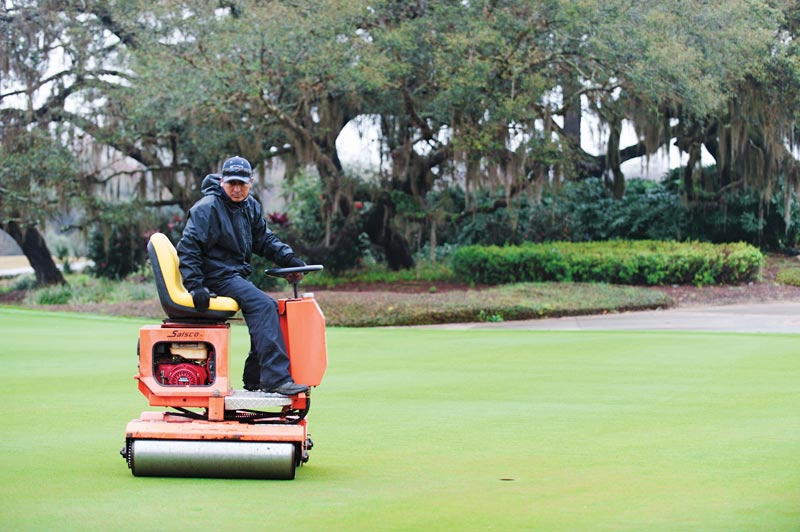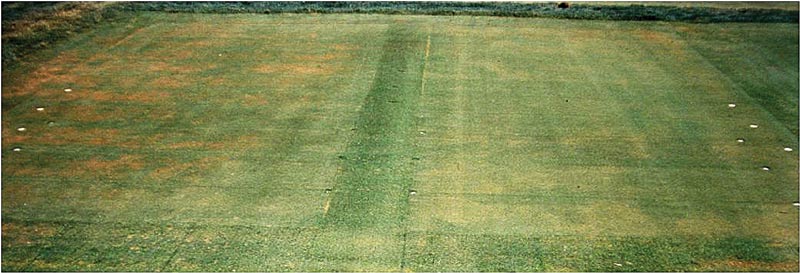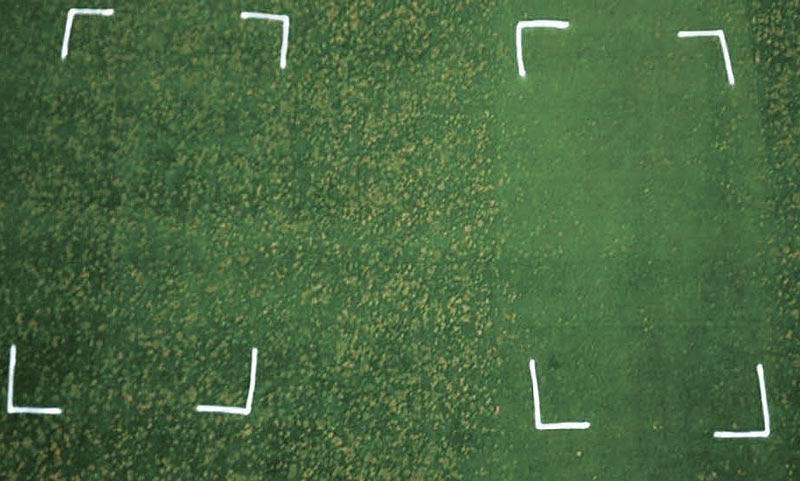
No other cultural or mechanical practice on the golf course can increase customer satisfaction as much as frequent use of a lightweight roller. Photo by Montana Pritchard
When I initiated my first lightweight rolling putting green study at Michigan State University in 1993, I had no idea I would still be researching the mechanical practice nearly 20 years later.
In the ’90s, the initial objective of lightweight roller research was to gather data to determine whether the practice was safe. Concerns included the limitation of rolling frequency because of the increased possibility of compaction, tissue bruising, and the more prevalent movement of diseases that are spread by mechanical means.
Just 10 years ago, lightweight rolling was primarily used to alleviate frost heaving, prep seed beds or increase green speed for tournaments — if it was used at all. Today, because of surprising results from research, lightweight rolling has been embraced as a means of creating healthy turfgrass and increasing customer satisfaction.
Because of my extensive research with the practice, I have been asked time and again to create a list of “The top 10 reasons to lightweight-roll.” I’ll admit to originally scoffing at the idea, but the truth is, I was the perfect individual to create such a list, so I finally gave in to the requests. What follows are my top 10 reasons to lightweight-roll.
10. Alleviate heaving and minimize scalping when climatic conditions dictate
The numerous freeze/thaw cycles that occur in temperate regions of the world result in soil frost heaving, which leads to bumpy soil surfaces in spring. It is customary to roll turfgrass surfaces before the first spring mowing to minimize the potential of scalping. Similarly, when heavy rains are followed by hot, humid weather, thatch can swell, creating puffy turf that is prone to scalping. Under these climatic conditions, rolling before mowing can decrease the potential of scalping.
9. Seed bed preparation
Rolling is important during the establishment of turfgrass sites for several reasons. First of all, on high-value areas, it is imperative to roll the site multiple times before seeding in order to compress the root zone and to reduce or eliminate soil settling during or following establishment.
Second, numerous turfgrass books rightfully preach the importance of having good seed-to-soil contact during the establishment of turfgrass sites, and the best way to have good seed-to-soil contact is to roll the site immediately after seeding. Additionally, in a putting green establishment study performed at Michigan State University, plots rolled multiple times per week filled in more quickly and were ready for play sooner than putting green plots that were not rolled.
8. Broadleaf weed, moss, algae reduction
No research plots have ever been designed to examine the impact of lightweight rolling on broadleaf weeds, moss or algae encroachment, yet related research has documented that lightweight rolling decreases each of them.
In a study performed at Michigan State University in 1996, putting greens rolled three times per week had fewer broadleaf weeds and less moss than greens that were not rolled. Furthermore, in 2008, University of Arkansas master’s degree student Jay Richards reported that lightweight rolling decreased algae encroachment. Exactly why regular lightweight rolling would decrease these pests is not known, but it is hypothesized that increased turfgrass density reduces all of them.
7. Decreased localized dry spot
A lightweight rolling study performed at Michigan State University from 1995 to 2000 revealed that greens rolled three times per week displayed significantly less localized dry spot than greens that were never rolled. Soil samples from the study showed that rolled plots retained more moisture and had more root mass than root zones that were not rolled. Obviously, increased soil moisture content and root mass could lead to less localized dry spot on the turfgrass putting surface.

Studies at Michigan State University and the University of Arkansas have shown that lightweight rolling decreases localized dry spot. Photo courtesy of Thomas Nikolai
In the past several years, measuring volumetric soil moisture content has become easier for researchers and golf course superintendents alike, as time-domain reflectometry (TDR) technology has been vastly improved. TDR measurements taken for lightweight rolling studies performed at Michigan State and the University of Arkansas have consistently shown that lightweight rolling does increase soil volumetric moisture content.
6. Height of cut raised and green speed retained
Figure 1 shows green speed measurements from the very first mowing height/rolling study. Plots mowed at 0.187 inch were rolled three times per week and were compared with plots that were not rolled and were mowed at 0.156 inch.
In the beginning of the study, plots maintained at the higher height of cut had slower green speeds compared with plots mowed at the lower height of cut. However, after a week and a half of rolling, plots maintained at the higher height of cut achieved green speeds as fast as (and in some cases faster than) plots mowed at the lower height. Interestingly, rolling resulted in enough residual green speed that the higher height of cut maintained the green speed of plots at the lower height of cut the day after rolling.
Since that original study, several other studies have been performed that validate those findings. Furthermore, Rutgers University has documented that rolling and increasing the height of cut decreases anthracnose, while Michigan State University has observed decreases in brown patch.
5. Decreased cutworm activity — maybe!
OK, this might be a stretch, but bear with me, and, if nothing else, you’ll learn that I am an honest individual.
At the Hancock Turfgrass Research Center at Michigan State, we usually don’t get enough black cutworms to warrant an insecticide spray. However, over a period of years, I had observed cutworms — along with their unmistakable chewing damage — on my plots, and their presence coincided with increased bird feeding. Therefore, I hypothesized that the birds were going after the cutworms.
The three years this happened, I counted bird-beak holes in the turfgrass before mowing/rolling. Plots rolled three times per week had significantly fewer bird-beak holes (and therefore fewer cutworms). Interestingly, the decrease in bird-beak holes was between 55 percent and 60 percent in each of the years, which seems pretty consistent. I now feel comfortable stating that I think rolling decreases cutworm activity, but in all truth, I did not count cutworms, so I cannot say it with 100 percent confidence. I’ll leave that up to you until a turfgrass entomologist performs a conclusive study.
4. Improved topdressing incorporation
In 2006, Michigan State University performed a lightweight roller/sand incorporation study on creeping bentgrass putting green plots. Treatments included control plots that were never topdressed with sand, topdressed plots with the sand brushed in when dry, and plots that were brushed and that then received a single pass with the True-Surface vibratory roller.
The day after topdressing, the plots were mowed with a walk-behind mower and the debris was collected in buckets and put in paper bags that were placed in an oven at 104 F to boil off water. Then the debris was poured into a bucket of water, in which the sand sank while the clippings floated. Clippings were collected with a net, and the sand was poured onto a very fine screen, returned to the oven and weighed. The result was that approximately 40 percent less topdressing sand was collected in the buckets when plots were rolled after brushing (Figure 2). These plots also had a faster green speed several days after topdressing and decreased organic matter content at the end of the season.
John Sorochan, Ph.D., performed a similar study on bermudagrass greens at the University of Tennessee and reported an 80 percent decrease in the amount of sand after a single pass with the True-Surface vibratory roller. To my knowledge, no university research study has tested whether non-vibratory rollers increase sand incorporation after topdressing.
3. Decreased dollar spot
In 1995, I noticed that research greens rolled three times per week had less dollar spot than greens that were not rolled. None of the data was statistically significant, and I was certain I would never make a similar observation. The following year, the rolled plots on my research greens had significantly less disease each time a dollar spot outbreak occurred. To say I was surprised would be an understatement.

Research greens that are rolled frequently show significantly less dollar spot disease. Photo courtesy of Thomas Nikolai
Since then, I have made similar observations year after year in my lightweight rolling studies. Additionally, in 2011, Paul Giordano, a Michigan State graduate student, reported that increasing the frequency of rolling significantly decreased the incidence of dollar spot. The obvious question is, “Why does rolling decrease dollar spot?” The answer is lengthy and a bit elusive, and heck, this is just a top 10 list. The important fact is that regular use of lightweight rolling does decrease dollar spot.
2. It’s the economy (rolling/mowing frequency programs)
I published the results of my dollar spot observations in a scientific journal in 2001, and understandably, many of my peers seemed skeptical. In 2002, I gave a presentation on the subject at the GCSAA Education Conference in Orlando, and several roller companies were so delighted that they have continued to fund my lightweight rolling research to date. Support from those companies (and the Michigan Turfgrass Foundation) has allowed us to study the effects of various rolling/mowing frequency programs over the years, including the three listed below.
1. Alternating daily mowing and rolling
In 2004, Michigan State initiated the first mowing/rolling frequency study by comparing mowing every day with alternating mowing and rolling on a daily basis. On research greens, alternating mowing and rolling improves turfgrass wear tolerance and produces green speed measurements equivalent to mowing daily. If you are thinking this might result in money savings, you are correct. University of Tennessee graduate student Dan Strunk performed a cost-analysis study that compared daily mowing with alternating mowing and rolling on a daily basis, and he concluded that alternating mowing and rolling could save the average golf course in Tennessee approximately $13,000 annually. This can be a very nice economic option, especially when heat stress is high on cool-season grasses or cold stress is high on warm-season grasses.
2. Mow and roll every day
We certainly are not considering saving money with this option. However, results indicate that both mowing and rolling every day produces consistent green speeds from day to day, possibly allows raised mowing heights for better turfgrass health and wear tolerance, and results in significantly more dollar spot control than mowing every day and rolling every other day.

On the spot: Among lightweight rolling’s many benefits are decreased localized dry spot and dollar spot. Photo by Montana Pritchard
3. Roll every day and mow every other
That’s right, rolling every day and mowing every other day. Of all the mowing/rolling frequencies I have researched, this one results in the most consistent green speeds from day to day, very good wear tolerance compared with mowing alone, and better dollar spot control than mowing every day and rolling every other day. Depending on your current rolling program, this option could result in some economic savings as well.
With the programs listed above, I have never observed an increase in compaction. However, all of my research plots have been on frequent sand-topdressing programs (every two to three weeks). An additional caution: When I rolled plots every day of the week, I always used the lightest rollers available on the market (Tru-Turf, DMI Speed Roller and True-Surface vibratory rollers) because they have been continual supporters of my research. I don’t want to imply that rolling seven days per week with a roller heavier than 550 pounds would cause compaction and therefore weaker turf; I am just cautioning that we do not know whether heavier rollers used daily would result in compaction. Although I am a big advocate of lightweight rolling and encourage every superintendent to roll greens, I am an even bigger advocate of proceeding with caution when making any changes to a putting surface.
1. Increased customer satisfaction
Golfer survey after golfer survey indicates that the condition of the putting surface is the No. 1 thing golfers care about. Lightweight rolling produces smoother putting surfaces, which result in truer ball roll and faster green speeds. No other cultural or mechanical practice can increase customer satisfaction as much as frequent use of a lightweight roller.
Finally, no other mechanical practice allows the superintendent the possibility of adjusting the green speed to make his clientele happy. To quote Walter S. Harbin from 1922, “I cannot conceive how a perfect putting surface can be developed or maintained without rolling.” I think Mr. Harbin would be happy with the conditions on the putting surface today, due in part to the use of lightweight rollers.
Thomas A. Nikolai, Ph.D., the “Doctor of Green Speed,” is the turfgrass academic specialist at Michigan State University in East Lansing, Mich. He writes the bimonthly column “Up to Speed” in GCM.